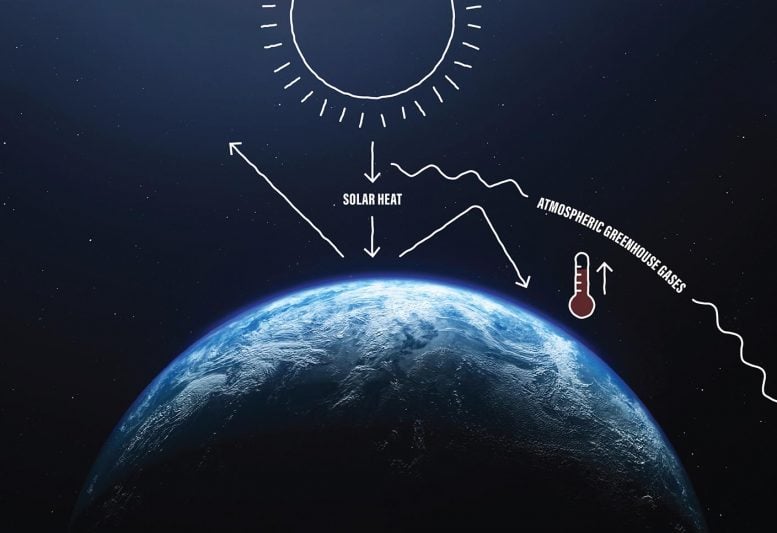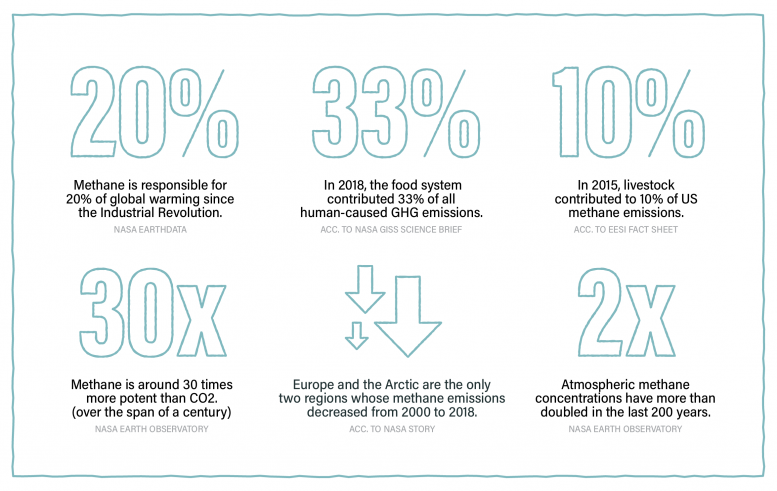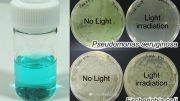
NASA scientists analyze the global methane budget to grasp the main sources of emissions and their role in climate change. Credit: NASA/Jesse Kirsch/courtesy of Tracy Schohr
Today, human sources are responsible for 60% of global methane emissions, coming primarily from the burning of fossil fuels, decomposition in landfills, and the agriculture sector. Nearly a quarter of methane emissions can be attributed to agriculture, much of which is from raising livestock. Rice cultivation and food waste are also important sources of agricultural methane, as nearly a third of all food produced for human consumption is lost or wasted.
At NASA, scientists study the global methane budget to better understand the primary sources of methane emissions and how they contribute to climate change. In addition to the human sources, methane is also produced in natural settings. The greatest natural source of methane is wetlands, which contribute 30% of global methane emissions. Other natural sources of methane emissions include the oceans, termites, permafrost, vegetation, and wildfires.
Atmospheric methane concentrations have more than doubled since the Industrial Revolution because of intensive use of oil, gas, and coal, rising demand for beef and dairy products, and increased production of food and organic waste. Although the increase in atmospheric methane concentrations slowed appreciably near the end of the 20th Century, concentrations have been increasing substantially since 2006, likely as a result of rising emissions from raising livestock, renewed reliance on natural gas and, in recent years, wetlands and global warming.
NASA’s new 3-dimensional portrait of methane shows the world’s second largest contributor to greenhouse warming as it travels through the atmosphere. Combining multiple data sets from emissions inventories and simulations of wetlands into a high-resolution computer model, researchers now have an additional tool for understanding this complex gas and its role in Earth’s carbon cycle, atmospheric composition, and climate system. The new data visualization builds a fuller picture of the diversity of methane sources on the ground as well as the behavior of the gas as it moves through the atmosphere. Credit: NASA/Scientific Visualization Studio
The Greenhouse Effect and Methane
Greenhouse gases, including methane, contribute to chemical reactions and climate feedbacks. The greenhouse gas molecules trap solar energy by acting like a thermal blanket. Energy from the sun is absorbed by Earth’s surface, though some of this energy is reflected into the atmosphere. The absorbed energy is also re-emitted at infrared wavelengths. Some of the reflected and re-emitted energy re-enters space, but the rest is trapped in the atmosphere by greenhouse gases. Over time, the captured heat warms our climate, increasing global temperatures.

Greenhouse gases in our atmosphere act like a blanket trapping heat from the Sun. This causes global temperatures to rise as the amount of greenhouse gases increases. Credit: NASA/Jesse Kirsch
The human-driven temperature increases can have an impact on methane released from natural sources. For example, permafrost can thaw naturally and emit methane into the atmosphere, but humans have increased the rate at which permafrost thaws due to human-caused warming.
Methane is the world’s second largest contributor to global warming, after carbon dioxide. Although carbon dioxide is more abundant than methane in the atmosphere, a single molecule of methane more effectively traps heat than a single molecule of carbon dioxide.
However, the lifetime of a molecule of methane is shorter than a molecule of carbon dioxide because of natural chemical processes that are quicker at scrubbing methane out of the atmosphere than carbon dioxide. This means that if methane emissions were to decline and the natural chemical scrubbing of methane maintained, atmospheric methane could decrease dramatically in just ten years. Decreasing the amount of methane put into the atmosphere could have a significant and nearly immediate impact on reducing the near-term effects of climate change and may contribute to keeping global temperature change below 2 degrees Celsius (3.6 degrees Fahrenheit).
Why Cows Produce Methane
Cattle, such as dairy cows or beef cattle produce methane as a by-product of digestion. Cattle are ruminant animals, meaning they have specialized digestive systems that allow them to process foods that cannot be digested by humans and most other animals, like fresh grass and uncooked grain. When food enters a bovine’s stomach, it undergoes a process called enteric fermentation: microbes and bacteria partially break down the food particles, which then ferment in the part of the stomach called the rumen. As the food particles ferment, they produce methane. Every time cattle belch – and, to a smaller extent, flatulate – methane is expelled and enters the atmosphere, where it acts as a greenhouse gas.

Methane fast facts: Methane is responsible for 20% of global warming since the Industrial Revolution; In 2018, the food system contributed 33% of all human-caused GHG emissions; In 2015, livestock contributed to 10% of US methane emissions; Methane is about 30 times more potent than CO2 over the span of a century; Europe and the Arctic are the only two regions whose methane emissions decreased from 2000 to 2018; Atmospheric methane concentrations have more than doubled in the last 200 years. Credit: NASA/Jesse Kirsch
NASA’s Eyes on Methane
While methane concentrations are well observed, emissions have to be inferred based on a variety of factors. NASA scientists use a variety of methods to track methane emissions. To get the most accurate estimates possible, they use emissions inventories from countries around the world, simulate wetland methane emissions, and combine this with ground-based, airborne, and satellite data using atmospheric models.
In California (and some other regions), researchers fly aircraft equipped with NASA’s Airborne Visible Infrared Imaging Spectrometer – Next Generation, or AVIRIS-NG, and collect highly calibrated data. This data is used in the California Methane Survey, a project jointly funded by NASA, the California Air Resources Board, and the California Energy Commission to rapidly identify and report methane leaks.
In Alaska and Northwestern Canada, NASA researchers use satellites, aircraft, and field research to better understand methane emissions from thawing permafrost as part of the Arctic Boreal and Vulnerability Experiment, or ABoVE. Researchers have discovered that carbon-rich permafrost is thawing at increasingly high rates, likely as a result of human-induced climate change, making the Arctic an important potential source of methane emissions. According to scientific estimates, this region’s soils store five times more carbon than has been emitted by all human activities in the last 200 years.
NASA researchers combine the data from missions like ABoVE and the California Methane Survey with their knowledge of how methane behaves in the atmosphere to create methane computer models. These models can help scientists and policymakers understand past, current, and future atmospheric methane patterns.
Paths Toward Reduced Methane Emissions
Researchers in a variety of fields have looked into potential solutions to decrease global methane emissions. For example, biogas systems reduce methane emissions by transforming waste from livestock, crops, water, and food into energy. Biogas is produced through the same natural process that occurs in landfills to break down organic waste. However, biogas systems harness the gas that is produced and use it as a clean, renewable, and reliable energy source rather than let it release into the atmosphere as a greenhouse gas.
A study led by Professor Ermias Kebreab from the University of California-Davis discovered that introducing a few ounces of seaweed into beef cattle diets could reduce their methane emissions by over 82%.
These types of technological – and biological – innovations may provide decision-makers, ranchers and others with more options for managing our future methane.









I’d care more if CA didn’t burn down their forests the last 5 years! Just think of all the CO2 sequestering forests which are now GONE!!!!
It should be noted that in the US alone, huge acreage that was formerly wetlands, such as in the Great Valley in California, and northern Ohio, pioneer farmers drained the wetlands to take advantage of the organic-rich soils. Were it not for the industry of the farmers, much more of the current methane would be natural. So much of the original wetlands were drained, that the federal government passed legislation prohibiting further modification without, difficult to get, permits because of the impact on the environment, notably migrating birds. Perhaps the methane that was formerly emitted by drained wetlands should be viewed as ‘methane credits’ for alternative sources such as cows.
The article tells us that methane has doubled in the last 200 years. However, I don’t know the basis of that claim because there was nobody measuring it even 100 years ago, let alone 200!
The article also says that methane is 30X more powerful than CO2 over a century. However, I’m pretty sure that is on a molecule-to-molecule basis. What would be more informative and objective, would be to tell us how much the forcing in watts/square meter for CH4 and CO2 is, and also provide the forcing for H2O.
If alarmists can’t play straight, and present objective facts, is it any surprise that many of us question the motives of claims that rely on big numbers to scare people?
To Clyde Spencer. Methane levels over time are reliably measured through Antarctic ice cores. This data is robust.
On relative impact of CO2 vs Methane, the article provides this figure obliquely when it states that Methane is responsible for 20% of global warming, so you are correct that it is a poor way of presenting the relavtive impacts.
The actual figure given by NASA is that atmospheric levels had increased to 1,800 parts per billion in 2015, from 1,640 ppb since 1984, continuing the trend upward. Thus, levels have risen from about 900 ppb at the beginning of the 1800s, and the rise to 1,800 is responsible for 20% of the warming effect.
So, in a roundabout way the article is trying to say that a reduction of 50% of atmospheric Methane would provide a rapid reduction of greenhouse impacts. But I agree with you, it could have been presented far better!!
As shown by the graphic here: https://scitechdaily.com/methane-levels-higher-than-previous-estimates-in-california/ methane does not appear to be as well-mixed as CO2. There appears to be something like at least a 5,000-fold decrease in methane from the Sacramento Valley to past the crest of the Sierra Nevada. With no wetlands within 100 miles of Antarctic, I don’t think that ice core measurements are representative of the global, or mid-latitude, CH4 concentrations. Thus, I’m not in agreement that the historical methane data are “robust.”
Also, the supposed increase in CH4 from ruminants grown for food doesn’t take into account the billions of Bison that formerly roamed across North America and even Europe, which have been replaced by cows.
This should be categorized an an opinion / editorial story. Usually, the articles here are interpretations of journal papers for the lay-person, which is of great benefit to the less aware members of the public.
Yes, homo sapiens sapiens are a cancer on the earth, and tend to destroy everything they touch, and war with each other. But that is an anthropological matter, which indirectly causes global warming.
How about citing a paper by James Hansen.
How about explaining why rice production in Asia is about as polluiting as beef production in western hemisphere — but about one-half as nutritious — and I’m VEGAN!
I am so sorry the article hurt your feelings, but the adults need to talk about this subject.
OK, start talking — like an adult. That means pointing out errors of fact and not just insulting someone that you disagree with.
James Hansen is not a reliable source. See my analysis of his seminal prediction.
https://wattsupwiththat.com/2018/06/30/analysis-of-james-hansens-1988-prediction-of-global-temperatures-for-the-last-30-years/
To Clyde Spencer. Methane levels over time are reliably measured through Antarctic ice cores. This data is robust.
On relative impact of CO2 vs Methane, the article provides this figure obliquely when it states that Methane is responsible for 20% of global warming, so you are correct that it is a poor way of presenting the relavtive impacts.
The actual figure given by NASA is that atmospheric levels had increased to 1,800 parts per billion in 2015, from 1,640 ppb since 1984, continuing the trend upward. Thus, levels have risen from about 900 ppb at the beginning of the 1800s, and the rise to 1,800 is responsible for 20% of the warming effect.
So, in a roundabout way the article is trying to say that a reduction of 50% of atmospheric Methane would provide a rapid reduction of greenhouse impacts. But I agree with you, it could have been presented far better!!